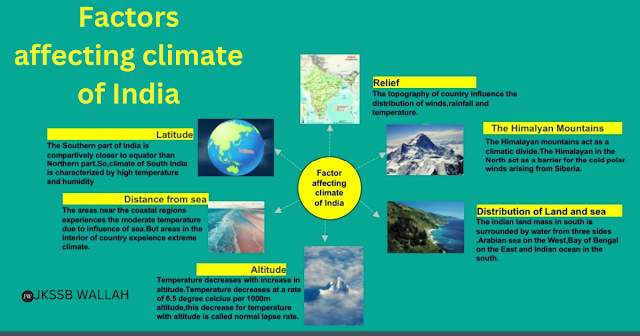Tropical wet: Western coastal region and Northeastern states
Tropical dry: Central and western part,parts of Rajasthan and Gujarat
Semi-arid: Parts of Maharashtra,Karnataka,Andhra Pradesh.
Arid: Western part of Rajasthan and parts of Gujarat.
Subtropical: Northern part of India,Uttar Pradesh, Bihar.
There are main six factors affecting the climate of India,These factors make the climate of India so diverse and beautiful.
 |
What are the factors affecting the climate of india. |
1. Latitude
Indian main land extent from 8°4′ North to 37°6 North.
Tropic of cancer passes through centre of Indian mainland and it divides the India into two halves North and South.South of Tropic of cancer experience tropics climate as it is near to equator.Whereas North of equator experience sub-tropical climate. As Earth is geoid shape and the solar insolution is not directly fall on all parts.The region near equator experience high temperature.The Southern part of India is comparatively closer to equator than Northern part.So,climate of South India is characterized by high temperature and humidity at the same time coastal region of south experience moderate temperature due to influence of sea.
The Northern part of India lie in warm temperate zone. Solar insolutions are compartively less in in Northern part.Summer season is hot (because of loo)and winter are cold (because of western disturbances).
2. The Himalayan Mountains
The Himalayan mountains act as a climatic divide.The Himalayan in the North act as a barrier for the cold polar winds arising from Siberia.If this mountain range is not in the North of India then whole India is like a cold desert.
The Himalayan mountains also act as barrier for the moisture-ladden winds which cause monsoon in India.This mountain range trap the monsoon winds and force them to shed the moisture within the Indian sub-continent.
3. Distribution of Land and sea
The location of India is also a blessing to Indian climate.The indian land mass in south is surrounded by water from three sides .Arabian sea on the West,Bay of Bengal on the East and Indian ocean in the south.The Himalayas in the North are act as a barrier.The basic principle of heat absorption is that land heats up quickly and also cool down quickly.Wheras the water heats up slowly and also cools down slowly.This differential heating and cooling of land and water creates different air pressure zones as high pressure and low pressure.The movement of monsoon winds also due to this pressure difference.
4. Altitude
Altitude plays an important role in shaping Indian climate. Temperature decreases with increase in altitude.Temperature decreases at a rate of 6.5 degree celcius per 1000m altitude,this decrease for temperature with altitude is called normal lapse rate.It affects temperature, precipitation, vegetation, air pressure, and wind patterns.Hence,places with higher altitude like Kashmir,Shimla,Himachal have lower temperature than plains.
5. Distance from sea
Indian coastline in the south is also an important factor that determines the climate of different parts of India.The areas near the coastal regions experiences the moderate temperature due to influence of sea.But areas in the interior of country like New Delhi experience extreme climate i.e, very hot in the summer and very cold in the winter season.The areas near coast have merely idea of extreme climate.
6. Relief
The diverse topography of India is also one of the factor which decide the climate of India.The topography of country influence the distribution of winds,rainfall and temperature.
The Himalayas in the North act as a barrier to Indian subcontinent and save India from cold siberian winds and alao help to retain the south-west monsoon winds in the country.This retention of moisture-ladden winds made the India an agrian economy.
The Aravalis mountain range also act as a divider of Rajasthan.West of Aravalis is hot desert whereas East to Aravalis is cultivated lands.
The south-west monsoon areas on the western slope of Western Ghats receive a huge amount of rain because it is on windward side.Wheras the areas on Eastern side like Maharastra,Tamil Nadu ,receive very little amount of rainfall due to its location i.e on leeward or rain shadow side.
7. Wind and air pressure
Winds move from a region of high pressure to region of low pressure.India lies in the region of North-Easterly surface winds. These winds originate during winter from the sub-tropical high-pressure belt of the Northern hemisphere. These winds blow South, get deflected to the right due to the Coriolis force and move towards the equatorial-low pressure region. These winds originate and blow over land and hence, carry very little moisture. Therefore, they bring no rain or very little rain. The unique feature of Indian pressure and wind conditions is its complete reversal. During winter high- pressure areas develop over the areas North of Himalayas. This causes cold dry winds blow from the area towards low- pressure area over the oceans to the South. In summer, due to high temperature, low-pressure area develops over interior Asia and over North-Western India. Air from high-pressure areas blow towards this region resulting in complete reversal of wind direction. As these winds from high pressure area of Southern Indian Ocean crosses the equator and turns right towards low pressure areas of Indian sub-continent. These winds gather large moisture while moving over the warm ocean and bring widespread rainfall over the mainland of India. These winds are known as the South-West Monsoon winds.
